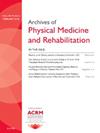提供者经验与综合医疗团体访问慢性疼痛
IF 3.6
2区 医学
Q1 REHABILITATION
Archives of physical medicine and rehabilitation
Pub Date : 2025-05-01
DOI:10.1016/j.apmr.2025.03.033
引用次数: 0
摘要
目的在寻求改善患者体验和护理质量时,医疗团队的福祉是一个重要的考虑因素。先前的研究发现,改变工作条件对改善医疗服务提供者的幸福感是最有效的。综合医疗团体访问(IMGVs)以可能影响提供者福祉的方式改变工作条件。然而,人们对医疗团队在临床环境中实施和维护imgv的经验知之甚少。方法通过Zoom和电话对21名临床医生、管理人员和工作人员进行访谈,这些人来自全国各地的安全网医疗机构,他们对慢性疼痛患者实施了IMGVs。要被视为IMGV,患者同时接受有执照的临床医生的护理,该医生记录了就诊情况,患者进行了互动,临床医生以身心练习的形式提供了综合医疗保健。访谈包括关于提供者经验、幸福感和对IMGV模型的满意度的问题。访谈由一组训练有素的定性研究人员使用主题内容分析进行记录、转录和编码。结果:作者确定了四个主题,描述了IMGV如何积极影响提供者的福祉:横向权力动态,与跨专业团队的合作,指导一致的护理,以及增强的意义和目的。第五个主题确定了在IMGV交付过程中直接影响提供者福祉的组织支持。目前的研究是第一次使用来自实施IMGV的医疗团队的访谈来评估他们的经验并了解对幸福感的影响。确定的主题值得进一步调查IMGVs作为促进提供者福祉和减轻倦怠方面的战略。本文章由计算机程序翻译,如有差异,请以英文原文为准。
Provider Experiences with Integrative Medical Group Visits for Chronic Pain
Purpose
The well-being of healthcare teams is an important consideration when seeking to improve patient experience and quality of care. Prior studies have found that changes to working conditions are most effective to improve provider well-being. Integrative Medical Group Visits (IMGVs) modify working conditions in ways that may impact provider well-being. However, little is known about healthcare teams' experience with the implementation and maintenance of IMGVs in clinical settings.
Method
Interviews were conducted via Zoom and telephone with 21 clinicians, administrators, and staff from safety-net healthcare settings throughout the country who have implemented IMGVs for patients with chronic pain. To be considered an IMGV, patients received care concurrently by a licensed clinician who documented the visit, patients interacted, and clinicians provided integrative healthcare in the form of mind-body practice. Interviews included questions about provider experience, well-being, and satisfaction with the IMGV model. Interviews were recorded, transcribed, and coded using thematic content analysis by a team of trained qualitative researchers.
Results
The authors identified four themes describing how IMGV positively affected provider well-being: horizontal power dynamic, collaboration with an interprofessional team, guideline-concordant care, and enhanced meaning and purpose. An additional fifth theme identified organizational supports that directly impact provider well-being during IMGV delivery.
Conclusion
The current study was the first to use interviews from healthcare teams who have implemented IMGV to assess their experience and understand the effect on well-being. The themes identified warrant further investigation into IMGVs as a strategy to promote provider well-being and mitigate aspects of burnout.
求助全文
通过发布文献求助,成功后即可免费获取论文全文。
去求助
来源期刊
CiteScore
6.20
自引率
4.70%
发文量
495
审稿时长
38 days
期刊介绍:
The Archives of Physical Medicine and Rehabilitation publishes original, peer-reviewed research and clinical reports on important trends and developments in physical medicine and rehabilitation and related fields. This international journal brings researchers and clinicians authoritative information on the therapeutic utilization of physical, behavioral and pharmaceutical agents in providing comprehensive care for individuals with chronic illness and disabilities.
Archives began publication in 1920, publishes monthly, and is the official journal of the American Congress of Rehabilitation Medicine. Its papers are cited more often than any other rehabilitation journal.

 求助内容:
求助内容: 应助结果提醒方式:
应助结果提醒方式:


